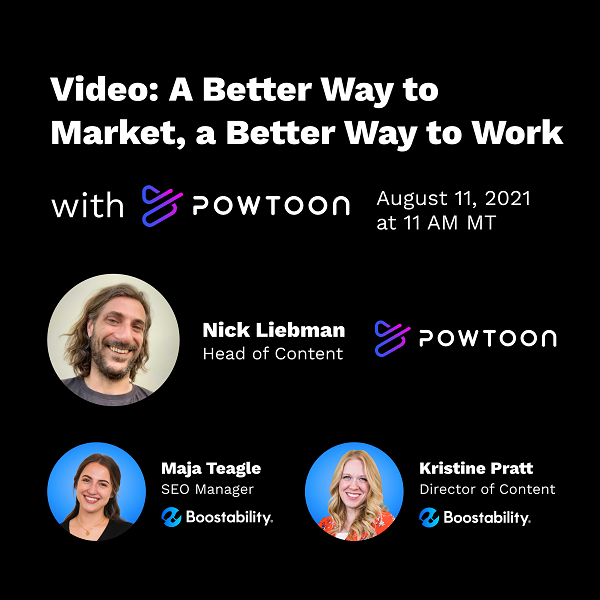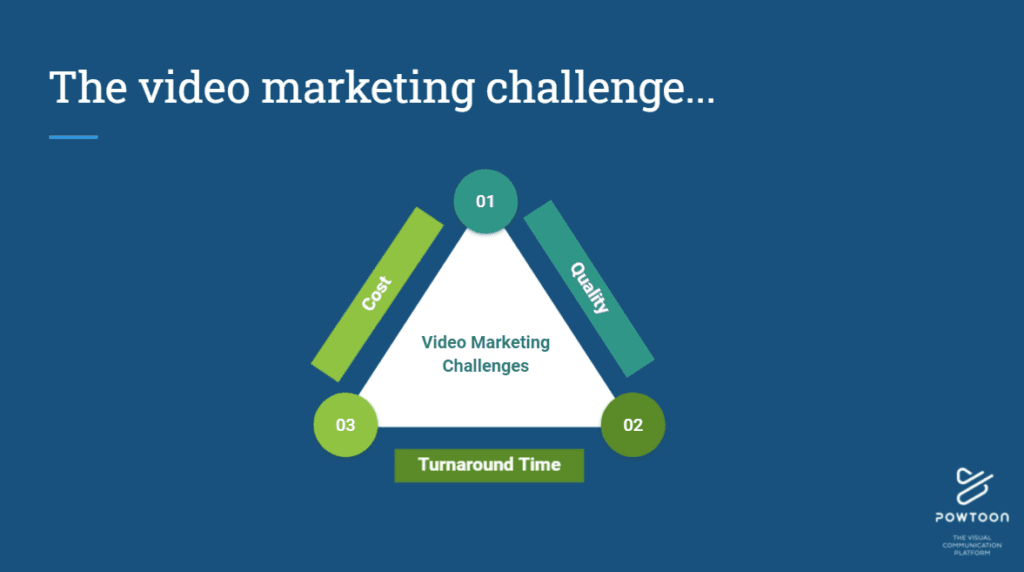Search Sessions – Video: A Better Way to Market, a Better Way to Work

Video is a massive tool in digital marketing today and a powerful way to reach new audiences and reconnect with the ones you already have. And it’s easier to do video marketing than you think!
We were joined by Nick Liebman, Head of Content at Powtoon, an all-in-one visual communications platform. “Powtoon gives you the freedom to create professional and easy to customize videos your audience will love.” We also heard from our SEO expert Maja Teagle about how to get your video ranking and make sure your audience sees what you create.
Watch our full Search Sessions here or read on for some key takeaways:
Age of Video
Video is more effective at capturing your attention and getting your message across than any other medium. Visitors spend 2.6x more time on pages with video and video keeps people engaged.
In a study by Wyzowl, marketers are saying:
- 86% of businesses are using video marketing
- 93% of marketers say video is key to their strategy
- 86% of marketers claim video has increased traffic
- 94% of marketers say video has helped them increase user understanding of their product and services
Video is essential to the shopping experience! Over half of people search for products first, then seek out videos for more information. Additionally, the video search “which [product] should I buy” Has grown over 200%. In Wyzowl’s study, they also found that 85% of people would like to see more videos from brands in 2021. Video is effective as a medium, marketers want to leverage it, and it’s how customers research products and make buying decisions.
There’s no denying that video is important. People would rather watch a video than pour through a PDF or another webpage and video will make it come alive for people.
What’s Keeping You From Creating More Video?
- Quality – you want your videos to reflect the quality of your brand, your product, and your service. You want it to make sense to your audience and match their intent.
- Turnaround Time – how fast can you create video? If you are working with an agency, there’s a back and forth between you and them, and that takes time.
- Cost – budgets are finite things and can only be spent once. The cost of your video impacts how much you can do.

Luckily, the culture of video is changing and making these obstacles less and less relevant.
What Kinds of Videos Can You Use In Your Marketing?
Product videos: If you don’t have a video that explains what your product is, who it’s for, why they should care, and what they should do next, you are really missing the boat. Video is helping users understand your product, keep visitors on your page, and help people find your website.
Promotional videos/ads: This is a huge opportunity, especially on social media. There are so many eyes on social platforms and you have the opportunity to pay to put ads in front of people. Most people are looking at a social feed with the sound off so you want to grab their attention with strong visuals and text.
Social Media: A lot of people leverage social media. Social Media is ephemreal, it comes and goes. That means you need to be able to create content quickly without a lot of overhead that people will engage in. You need a tool that helps you create quickly and efficiently without a lot of people involved.
YouTube: The videos you post on YouTube are highly discoverable. YouTube is the 2nd most used search engine because people are going there to find videos to meet their needs and meet their intent. If you create and post videos that your audience is searching for and meet their needs, it will help build a valuable brand reputation. Your videos have a life beyond the day you publish, almost like virtual real estate.
Webinars: Webinars are a great way to connect with your current and potential customers, a way to make a connection.
Screen recording/Video messaging: It’s a very powerful way to make content. A great tool for social media. Your video doesn’t need to be high quality, it needs to be authentic.
Make sure to check out Nick’s video tutorial in our YouTube video (linked above)!
. @nick_liebman is showing us an INCREDIBLE @Powtoon video tutorial right now!! (make sure to watch our Search Sessions when we upload it after the show!) #BoostSearchSessions
— Boostability (@Boostability) August 11, 2021
The 21st Century Workflow Is All About Video
It’s all about video. Instead of a long email, or a stupefying spreadsheet, or a marathon meeting, think about using video and visual communication for:
- Content creation
- Edits and Feedback
- Marketing/Sales Handoff
- Reporting success
- Onboarding/training
- Offboarding/Knowledge capture
- Communication with contractors/vendors
Video is a language we are all much more fluent in than we used to be. We can apply it to not just marketing but also how we work. Video is easier and more effective than before, we are in a moment of experimentation. It’s a common language and we walk around with a video production studio in our pocket every day. Not only can we apply it to our marketing, but we can apply it to how we work with our teams, clients, and company.
Video is about sparking conversation. #BoostSearchSessions
— Boostability (@Boostability) August 11, 2021
5 Steps to Get Your Videos Found on YouTube
Here are five basic steps for Video SEO to help give you leverage on YouTube and rank higher for searches.
Step 1: YouTube Keyword Research
Start by doing a search in YouTube for the topic of your video and check what pops up in the autocomplete feature. Autocomplete suggests popular keywords and searches which will give you a better idea as to what people want to watch and what they are actively searching for. This feature also shows long-tail keywords which tend to be less competitive, and therefore, increase your likelihood of ranking for those keywords faster.
Do competitive research and identify which keywords your competitors are using on their channels, video titles, and video descriptions. Cross-reference your organic keyword list used for traditional SEO on Google or other search engines. Diversify your keyword list to include target keywords that tend to have higher search volume as well as less competitive, long-tail keywords.
The same rules still apply with Video SEO as they do with traditional SEO, and that is to manually inspect the intent of each keyword to ensure that it’s aligned with your content. Aim for keywords that actually show videos and YouTube links in the first SERP. Studies have shown that how-to, review-based, and tutorial videos rank the best for video searches.
Step 2: Publish High-Retention Videos
- Saying your keyword in the video: Say your keyword in the video because YouTube automatically transcribes it.
- Including a summary: Include a summary of your video right at the start. This gives people context and a preview as to what will be discussed in this video and reassures them that they are in the right place.
- Getting straight to the point: Avoid long intros and fluff. Immediately jump into the main takeaways to keep viewers engaged. People want information immediately and taking too many roundabouts increases the risk of drop offs.
- Using open loops: Keep people engaged by dropping a preview of what will be discussed later in the video. It keeps people engaged and alert of what’s to come so they don’t leave.
- Understanding video length: Similar to traditional SEO, focus on producing videos that answer people’s questions and provide genuine value versus how long the video should be. No matter the video length, aim to be concise, accurate, informative, and avoid being redundant.
Step 3: Optimize Your YouTube Video
- Video title: Use your target keyword as close to the beginning of the video title as you can and aim for natural language rather than keyword stuffing to avoid coming off as spammy. Consider click through rates. Achieving a high click through rate is essential for YouTube SEO, so test out different formats and strategies to find what generates the most clicks and traffic to your videos. Studies have also shown that you can get a third more clicks to your page and video by just using brackets and parentheses in the title as they capture attention and provide context.
- Video descriptions: Make your video description at least 250 words and use keywords throughout it approximately 2-4 times. As you’re writing the description, again, focus on natural language and avoid keyword stuffing. The longer the description, the more space you’ll have to write something enticing and sufficiently incorporate keywords. However, it’s a balancing act of doing that and not being repetitive.
- Tagging videos: Tags help viewers find you on YouTube so make sure to add them into new and existing videos. Create tags for your target and supporting keywords, as well as long-tail, more specific tags that support the overarching theme of the video. Be clear and intentional with your tagging strategy to avoid confusing viewers and YouTube.
Step 4: Embed and Promote Your Videos
Embed and promote your video and overarching channel. Click through rate is a major factor in increasing your rankings on YouTube. Properly embedding and promoting your video across your social media channels, email marketing campaigns, website and blogs, appropriate forums, and more can help expand your reach and get more clicks and traffic to your video.
Step 5: Increase Engagement Signals
Focus on increasing engagement signals such as likes, comments, and subscribers. Increasing engagement signals is strongly correlated with higher rankings on YouTube. The best way to get more likes and comments is to directly ask people to take that action and to ask specific questions. Avoid generic closing statements like, ‘Let me know what you think in the comments section!’ and instead say something along the lines of, ‘Which of those tips are you going to try out in your strategy? Drop your answer below!’
The same applies with getting more people to subscribe to your channel. Ask them to do so but give them a reason. Be very clear about the value they’ll receive by subscribing and watching your videos, and what they will miss out on if they don’t.
Put Video to Work for Your Marketing & Your Team!
Sign up at Powtoon.com
Download the Powtoon Capture Chrome Extension
Check out Powtoon’s Template Gallery
Want more? Get 15% off any Powtoon premium plan with the code ‘Event15’
If you need a boost with your SEO – Boostability is here to help! Reach out to us on our website at Boostability.com!

